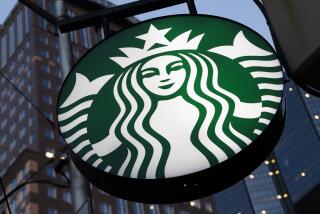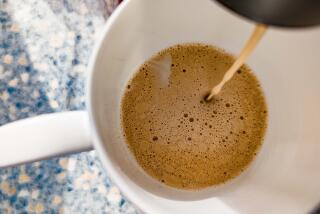Specialty Coffee Emerges as Hot-Selling Product : Trends: Espresso bar craze is spreading from Northwest to other parts of the country. The high-quality brews are the fastest-growing segment of the coffee market.
YAKIMA, Wash. — Terry Jones walks a mile for an espresso--not any old cup of joe, but the specially made brew at Joan Nygaard’s sidewalk cart.
“Once people taste good espresso, it’s hard to go back to a brewed cup of coffee,” Nygaard said. “It’s like the difference between Mad Dog and good wine. It seems like in the last year everyone’s gotten the fever.”
Indeed, the Seattle-spawned craze for fresh, high quality coffee is moving east. You can find espresso in Minneapolis and in Bozeman, Mont., where actress Glenn Close co-owns a shop. Coffee bars have sprung up all over California, and in Chicago, St. Louis and other outposts.
“We can see it formulating all across the country because we get the phone calls . . . ,” said Ted Lingle, director of the Specialty Coffee Assn. of America in Long Beach. “New York City next year will have a lot of coffee shops and espresso carts.”
And that’s no java jive. Consider these facts:
* Specialty coffees--just about everything that doesn’t come from a supermarket can--are the fastest-growing coffee segment, slurping 20% of the U.S. market. It was 11% in 1984. Meanwhile, overall coffee consumption nationwide remains flat.
* The recent public stock offering of Seattle-based Starbucks Coffee Co., the nation’s largest specialty roaster, was wildly popular and the price of the shares has nearly doubled.
* Yakima, a meat-and-potatoes city of 57,000, has 20 to 30 espresso carts and stores littering the streets, shopping malls and lobbies of office buildings, most opening in the past year. West Valley High School in suburban Yakima has an espresso cart, to the displeasure of state education officials worried about providing caffeine for students.
Espresso was invented in Italy at the turn of the century. The name refers to the high-pressure way the water is forced through the coffee grounds, compared with the more common brewing by gravity in percolators. The term also refers to the color and blend of the beans.
There is a lot of money to be made in those beans. Carts can be set up for $5,000 to $20,000. Then owners can take a shot of coffee, some steamed milk, water, perhaps a flavoring and charge 85 cents to $2.85 a cup, depending on the combination.
The king of the new coffee business is Starbucks, founded in 1971 and named for the first mate in the novel “Moby Dick.”
Company President Howard Schultz said the firm has 150 company-owned retail stores, and plans to open 75 more over the next 12 months. It also ships fresh-roasted coffee by mail to customers in all 50 states. It provides the coffee for all the espresso bars at the upscale Nordstrom department store chain and for the Washington State Ferries system.
Starbucks is the coffee sold at Chicago’s Wrigley Field and Comiskey Park. It is, boasts Schultz, “the largest roaster and retailer of specialty coffee in North America,” roasting about 7 million pounds of beans per year.
He expects specialty coffees to account for 30% of the market by 1994.
The specialty coffee business arrived in the United States about 20 years ago, when a few companies began seeking out the best coffee beans, known as arabica beans, from the best high-altitude farms, Lingle said.
Most coffee sold in supermarkets is made from robusta beans, which are grown for high yields at low altitudes, and stay on shelves for weeks before they reach consumers, Schultz said.
A 1983 trip to Italy by Schultz introduced him to some of the 200,000 coffee bars in that country. The next year Starbucks opened its first coffee bar in Seattle. “Prior to that the coffee bar in the Northwest was nonexistent,” Schultz said.
Starbucks, with 2,000 employees, now has strongholds in Portland, Ore., Vancouver, B.C., Southern California, San Francisco and Denver. The East Coast is due for invasion next year, Schultz said.
“Specialty coffee is a very affordable luxury,” Schultz said. The cliche image of the espresso drinker may be a Volvo-driving yuppie in a business suit. But Schultz insists the Starbucks customer is everyone from office workers to college students to thermos-filling truck drivers.
The espresso craze has spawned a booming business in the making of carts, said Bob Burgess, owner of Burgess Enterprises in Seattle.
Last year the company got 15 calls a week from people seeking to buy espresso carts. Now the number is between 40 and 70 calls per week, he said.
Burgess Enterprises sells fully equipped espresso carts for $13,000 to $20,000, and offers advice in securing good locations, and in preparing and marketing espresso.
The company believes the espresso market is far from saturated.
“It will become a type of menu item stores have to have, much like coffee is a menu item anywhere there is food service,” said Robynn Hergert, director of national cart sales.
A Crash Course in What to Say When You Belly Up to the Espresso Bar
So just what exactly is an espresso? Here are some definitions.
* Espresso: A one-ounce shot of intense, rich black coffee made and served at once.
* Caffe Latte: A shot of coffee, with a healthy covering of hot steamed milk, and up to a quarter-inch of foamed milk on top.
* Cappuccino: A shot of coffee, followed by less than half a cup of steamed milk and a big head of foamed milk to contain the warmth.
* Espresso can Panna: A shot of coffee topped with whipped cream.
* Caffe Americano: a shot of coffee, with the rest of the cup filled with hot purified water.
* Caffe Mocha: Chocolate syrup on the bottom of the cup, topped with espresso coffee, steamed milk, whipped cream and chocolate sprinkles.
There is also a precious kind of verbal shorthand that has developed among Seattle’s espresso lovers. Here are a few examples:
* A Quad is an espresso drink with four shots of coffee.
* A double Cher is a single shot of espresso with steamed skim milk and two packets of the sugar substitute Equal, which is endorsed by the actress.
* A Harmless is a double shot of decaffeinated coffee and nonfat milk.
* Double Dry Short is a double shot of espresso in a short cup with no foam.
More to Read
Eat your way across L.A.
Get our weekly Tasting Notes newsletter for reviews, news and more.
You may occasionally receive promotional content from the Los Angeles Times.










